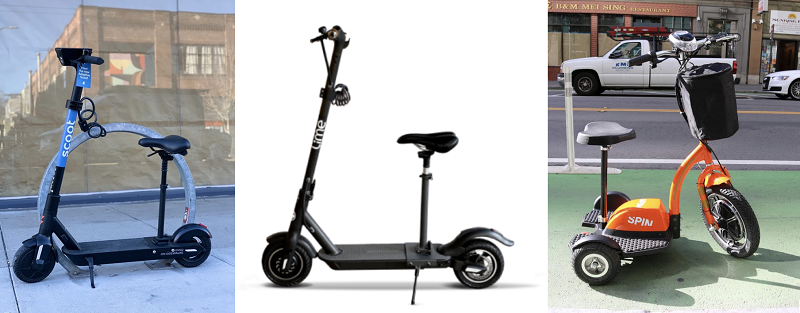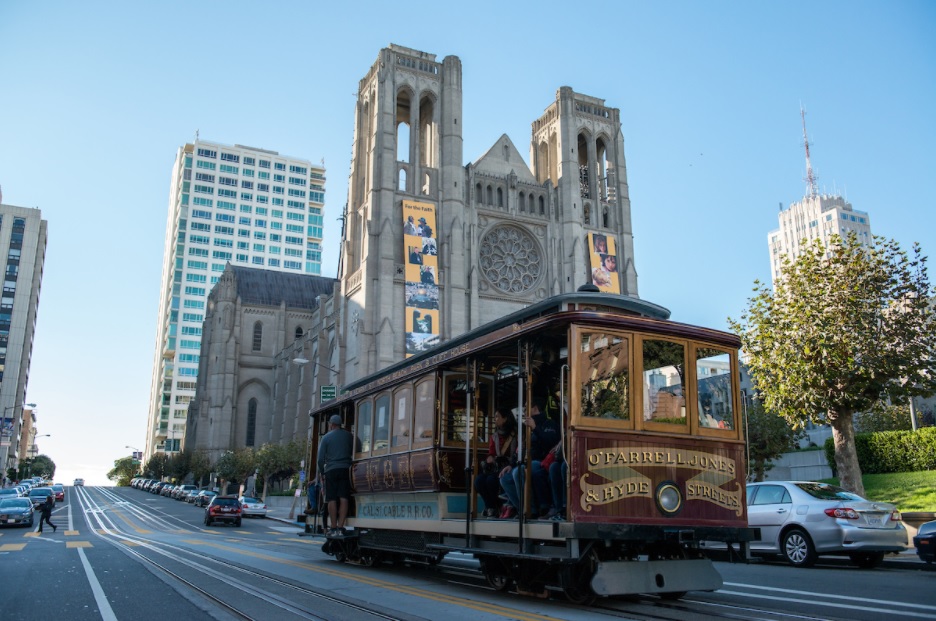Saturday, September 4, 2021
Friday, September 3, 2021
Adaptive Scooters Coming to a Street Near You
By Rachel Vierstra
 Shared Powered Scooters have grown in popularity over the past few years, giving residents and visitors to San Francisco one more alternative to traveling by car. Scooters can provide increased access to nearby necessities and a fun option for shorter trips. However, standard scooter models are not accessible to many people with disabilities.
Shared Powered Scooters have grown in popularity over the past few years, giving residents and visitors to San Francisco one more alternative to traveling by car. Scooters can provide increased access to nearby necessities and a fun option for shorter trips. However, standard scooter models are not accessible to many people with disabilities.
Motivated by our dedication to providing equitable access to transportation, the SFMTA required all powered scooter permittees to pilot an adaptive scooter program from January 2020 to June 2021. From that pilot, a first of its kind among U.S. transit agencies, we learned important lessons that inform how we can best require scooter operators to expand access for disabled riders moving forward.
2019-2021 Adaptive Scooter Pilot
The 2019-2021 scooter permittees, Scoot, Lime, and Spin launched their adaptive scooter pilots with devices that provided additional stability, such as a seat, a wider base, and an additional wheel. Each of the three pilots offered multiple options for reserving an adaptive scooter, including submitting a request through an online form, calling directly, or reserving through the company’s app. Once reserved, users were able to pick up the scooter from the company or have it delivered directly to them.
Throughout the pilot, the permittees were required to connect with different disability organizations to evaluate their program’s efficacy and solicit feedback on how best to meet their needs. This included surveys of users and roundtables with local disability organizations, including LightHouse for the Blind and Visually Impaired, Ability Now, Walk San Francisco, and the Community Living Campaign.
What We Learned
At the end of the pilot, the SFMTA required the permittees to conduct an evaluation of their programs to identify strengths and weaknesses and to share what they learned. The program had many successes during the trial period. All three permittees were able to offer the adaptive scooter rentals free of charge (Lime had a $5 refundable deposit), making the program financially accessible. In addition, based on user feedback, permittees were able to make modifications to existing models and introduce new, more useful models to their adaptive fleets during the pilot program. For example, all permittees altered seats so they could be raised and lowered based on the user’s height, and Lime and Spin added baskets so users could carry personal belongings. Starting in February of 2021, Scoot placed some of their adaptive scooters on the street, allowing anyone to rent them on demand.
By the end of the pilot, 158 different people had rented an adaptive scooter at least once, for a total of 786 rides. Input received from the community throughout the pilot underscored the importance of offering an array of scooter models that allow people with different mobility needs to access the program.
Incorporating lessons learned from the pilot program, permittees are now required to provide adaptive scooters as a minimum of 5% of their on-street fleet.
What’s Next: Permanent Adaptive Requirements for Scooter Operators
The new scooter permit began July 1, 2021 with Spin and Lime and on August 20 for Scoot. All on-street adaptive devices are rentable from the permittee’s existing mobile app, meaning a rider can reserve and ride an adaptive scooter in the same way as a standard scooter. The adaptive scooters must feature at least two of the following expansions to increase access: 1) three wheels, 2) seat, or 3) basket. Rental costs for adaptive scooters must be equal to or less than the rental cost of a general fleet scooter.
In addition to requiring the on-street adaptive scooters, SFMTA also incentivized permittees to continue piloting and testing additional adaptive scooter devices and service models, such as rental/testing hubs out in the community, pick up and drop off services, and additional community partnerships.
Learn More
Join us September 12, 2021 in Golden Gate Park to test ride an adaptive scooter! This adaptive transportation event will also feature our adaptive bikeshare pilot program and information about the Golden Gate Park Access and Safety Program. In addition, the scooter permittees will be sharing an adaptive scooter update at the Multimodal Accessibility Advisory Committee (MAAC) meeting on September 30, 2021.
Published September 04, 2021 at 12:21AM
https://ift.tt/2YrMoWf
Thursday, September 2, 2021
Celebrating 148 Years of Cable Cars in San Francisco
By Pamela Johnson

On September 4, 2021, San Francisco’s historic cable cars will return to revenue service after an unprecedented shut down of more than a year as part of the city's emergency response to protect operators and the public during the Covid19 pandemic. Coincidentally, this reopening marks the 148th year of cable car operations in San Francisco.
Rebooting the cable car system required significant work. As the cars had been out of service since March 17, 2020 we had to recertify and hire new line inspectors and prepare the cable cars’ historic infrastructure to accommodate service. Cable car testing began with the Powell-Hyde line in July. In August, the SFMTA announced that free test rides would be offered to the public on all three lines as we worked out possible kinks in the system, leading to this month's return of the landmark cable cars.
All aboard? Ding! Ding! A familiar sound is in the air again. It's time to experience San Francisco once more with a ride on one of the city's landmark cable cars. When was the last time you were on board? Shop, dine, and visit your favorite destinations along the cable car line and support the reopening of San Francisco's economy.
Andrew S. Hallidie, an engineer originally from Scotland, conceived his idea for a steam engine-powered, cable-driven rail system in 1869 after witnessing horses being whipped as they struggled to pull a passenger car up the wet cobblestones of Jackson Street.
Hallidie then entered into a partnership to form the Clay Street Hill Railroad, which began constructing a cable line on Clay Street—creating the first cable car line in the world, which launched in May 1873.
Opposition & Threats to the Cable Car System
The existence of San Francisco's cable cars has been threatened over and over again throughout the years. They have persisted through two World Wars and The 1906 Great Earthquake, and have outlasted political attempts to remove them from city streets in the late 1940s and 1950s, eventually becoming the international symbol of San Francisco that they are today.
In 1946, the cable cars almost saw their extinction when some city leaders, including then-Mayor Roger Lapham, wanted to tear out the 1870s-era transit system. The wooden vehicles towed by an underground cable system were seen more as a costly nuisance than a joyous marvel. In the same year, however, Friedel Klussman founded the Citizens Committee to Save the Cable Cars. The committee began a public campaign proclaiming that the cable cars’ value to San Francisco was far greater than their operational costs. They succeeded in placing an amendment on the ballot. With newspaper coverage, public support quickly grew. Celebrities voiced their support for cable cars as well. The measure passed in a landslide victory, and the city of San Francisco had rallied to save the Powell Street cable car system.
Despite a shut-down in the 1980s for system reconstruction and the more recent pandemic-related service suspension, cable cars have proven to be an enduring legacy of San Francisco. We appreciate the patience of our riding public as we work to bring this service back better than ever.
To learn more about the history of San Francisco's historic cable cars, visit San Francisco's 148 Years of Cable Car Service, Then and Now: Keeping the Cable Cars on the Move and the Cable Car Museum webpages. You can also sign up for cable car service updates on our SFMTA alerts page.
Published September 02, 2021 at 09:09PM
https://ift.tt/3BCZvlA
Wednesday, September 1, 2021
Tuesday, August 31, 2021
Monday, August 30, 2021
Liked on YouTube: How to open a gmail account
via YouTube https://www.youtube.com/watch?v=Isax4RamJKo
Sunday, August 29, 2021
Liked on YouTube: Guiter tone /107
via YouTube https://www.youtube.com/watch?v=U1Ry867rWKk
View24
View24
-
The 150 Year History of Muni’s ‘Newest’ Route: The 15 By Jeremy Menzies With the return of Muni’s 15 route earlier this year as the 15 Bay...
-
Tell us What You Want Muni Service to Be Like in 2022 By Shalon Rogers The 15 Bayview Hunters Point Express is one of Muni’s newest routes...
-
View24
-
q www.masicdeel.blogspot.com
-
Bringing Back Muni Better By Julie Kirschbaum Much of Muni service has already been restored since the pandemic-related service reductions...
